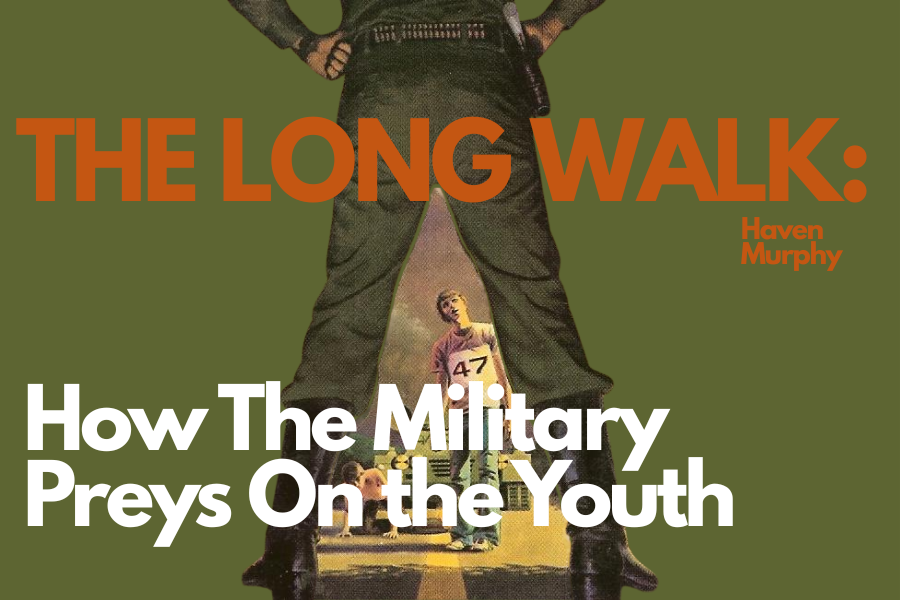“The Long Walk,” originally written by Stephen King in 1967, debuted its film adaptation in September 2025. The film is set in a dystopian, authoritarian society, and depicts a large group of young boys of various backgrounds participating in “the long walk,” which includes walking an endless road at a consistent pace of 3mph until one remains. If anyone falters from their pace more than three times, attempts to injure another walker, or leaves the road, they will be executed by a soldier. The last walker standing is rewarded a large sum of money and a wish. In the film, central character Ray Garraty states that despite the long walk operating on a “volunteer” basis, no one actually has a choice in the long walk. This, as well as the film itself, symbolizes the military and war, oppression, naivety and a society accepting of violent norms, rather than opposing them.
In “The Long Walk,” a draft occurs. Nationwide, teenage boys enter the long walk and are chosen via lottery. While the novel was being written, a teenage King lived through the Vietnam War draft that occurred throughout the 1960s and early ’70s. The boys of the long walk were subjects of their policed and dystopian society–poor and desperate, similarly to the young men who were primary targets of the draft for the war. Oftentimes, if you weren’t from a working class family, could afford further education outside of high school, or had military and political connections, the chances of being drafted weren’t zero, but were still vastly lower than if you were young, of good health and working class. An article about the anti-Vietnam war movement from 1965 to 1972 done by the University of Michigan claims that of the 2.5 million enlisted men who served in the war, 80% came from working class families.
Though the draft does not exist today, military service is still offered as an opportunity or a “way out” for young people–particularly students–of low income backgrounds who may not be able to afford college or who didn’t perform well in school. Similar to “The Long Walk” where participants are promised money if they win, people joining the military after high school become eligible for the GI Bill, which is a federally administered set of funds advised to aid in education, tuition, training and housing. Military recruiters are often in schools with promises of materialistic things that appeal to teenagers, like financial security and even electronics. Such promises create an incentive to go into a world that hosts possibilities no one is really ready for. Just as in the story, where Walker Hank Olson began the long walk confidently, believing that his preparation would leave him the last standing. However, his strategies rendered futile against the death grips of the long walk and the soldiers surrounding him—he dies as he exclaims that he “did it all wrong.” There is no way to correctly prepare to win in a world where there is nothing to win.
Under Richard Nixon’s presidency in 1971, the voting age for all Americans was lowered from 21 to 18 years old. Years before, in 1942 during World War II, a similar instance occurred where the draft age was lowered to 18 due to the sheer amount of casualties of young men. During the Vietnam war, teenagers were being sent out to fight, yet were still unable to vote for the person sending them out. The slogan, “Old enough to fight, old enough to vote” forced the law into place after almost 30 years of being proposed.
While there are strict rules in the United States about minors in the military, joining is still pushed onto people freshly out of school. While the military offers structure for people who are often looking for it—like teenagers and young adults- as well as support and benefits, the support offered is outweighed by the possibilities of intense, traumatic experiences, many of which are often caused by the same country one is fighting for. In hindsight, it’s a minimal reward for a maximum risk.
Teenagers are vulnerable and easy to influence. If you’re young and online, you can see how easy it is for specific age groups to follow after one another—whether it’s something funny, fashionable, or even a set of ideas positive or negative. Selling something to a bunch of susceptible, young individuals isn’t the hardest thing to do, especially if it’s being sold with promises of support, money, anything else someone would need or want and even a different, better life than they may have now. Military involvement is also pushed onto the youth because our government allows it. As per the No Child Left Behind Act, which is known for establishing state testing, military recruiters are allowed in schools.
“The Long Walk” is an allegory for the military, vulnerability and war—particularly the Vietnam war—through and through. From the surface level military presence and dog tags to the embedded characteristics of the boys, color schemes and the way the major speaks of the long walk’s patriotic contributions—how the boys’ walking to death will better the country. But who is it better for?










William • Oct 6, 2025 at 1:30 pm
Amazing, great read and interested me a lot.